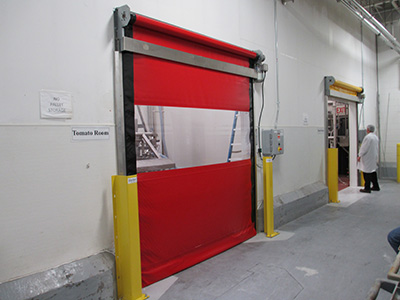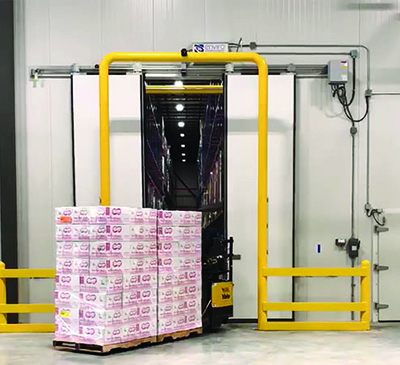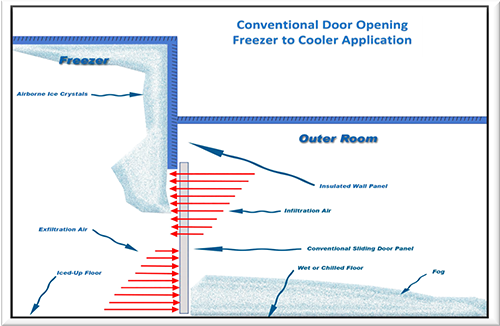 Next Generation Door Systems Help Control Energy Costs While Keeping Produce Safe
Next Generation Door Systems Help Control Energy Costs While Keeping Produce Safe
A produce processing operation can involve at least three sub-environments under its roof. At minimum, fruits and vegetables at the docks come into the processing facility from the field and shipped. In between, produce can be chopped, cooked, frozen, cleaned, bottled, or processed into a new product.
Protecting food quality along the material-handling chain, which can have heavy traffic, in such environments requires the right kind of doors. When adding other non-produce ingredients, the process becomes even more complicated.
The goal for these operations is preventing the airborne pathogens that can ride along with the raw material coming in through the receiving dock door from becoming part of the packaged product when it goes out the door. At the same time, certain areas within the facility need to maintain temperature levels to attain desired product quality levels.
Here are the conditions that exist in the processing plant that management needs to address in order to prevent cross-contamination and protect product quality.
Keeping Pathogens In Their Place
In many cases, product arrives on the receiving dock raw from the field with the dirt, contamination, and micro-organisms that exist in the outside world and are ready to go airborne once picked up by building positive or negative pressures.
While we’re on the topic of invaders, pests can be a problem. The 8-by-10- foot doorways at receiving docks are rarely closed in busy facilities, as one truck after another pulls up to unload.
Though the open end of the truck is enveloped with dock seals and shelters, there still can be gaps which enable entrance for insects. No processing process is totally closed-circuit, and, at some point, there is product exposure to the atmosphere.
For these intruders, the high-speed doors leading into the processing area prevent most of these contaminants from going any further than the dock. Tight sealing where the door meets the doorway also blocks these attacks on product quality.
Keeping Cool Or Freezing
Cold air is a valuable commodity in processing operations to prevent pathogen growth and product spoilage, but it is costly as well. To protect both the product and the energy budget, door design should guard against energy loss. That means the doors leading into processing operations must provide a tight seal. For freezer environments, door panels need to match the R-rating of the room’s walls.
Speed also counts. The faster the door opens and closes, the less time for cold air to escape the room. With operations optimizing floor space by using high racking in storage areas, increases in door speed minimize doorway exposure.
The Difference Is In The Door
Given the unique areas throughout a produce processing plant, here are the door design choices available to plant management.
Fabric roll-up.
For quick access, offering operating speeds of up to 100 inches per second. Separates room temperature differentials of up to 35°F. Full perimeter seal, including a soft bottom edge that conforms to floor profile. Breakaway design enables automatic curtain reset for minimal doorway exposure. Curtain panel material can withstand frequent washdowns. Side guides and headers are available in stainless steel. Door profile means installation in areas where wall space is tight.
Sliding solid panel.
For years, produce handling operations where temperature differentials between rooms is more than 35°F have lived with thick yet lumbering doors with sliding door panels. These were perfect targets for forklifts, leading to panels being bent out of shape, and gaps forming between the door seals. Or worse, panels getting penetrated by the force of the forces or knocked off the walls, stopping the operation.
The door industry’s latest development is sliding doors with an impact-resistant design, a feature food handling operation could not envision even a decade ago. As there is no floor hardware to guide panel travel, when a forklift clips a panel, it swings 90 degrees out of the way. Along with saving maintenance costs, the impactable design means that the doorway is always sealed to protect product quality and traffic continues to flow.
Even when the door does get hit, the driver can keep on heading onto the destination because the door’s auto-reset panel guidance system returns the door panels to a fully sealed position, ready to open for the next forklift.
In addition, these doors’ fast operating speed — 50 inches per second for single panel doors and 100 inches per second for bi-parting models — leaves little opportunity for cross-contamination. Versus vertical roll-up doors operating at the same speed, a bi-parting door can provide faster access to a tall doorway and that means less exposure time for the opening.
The doors have R-17 rated 4-inch panels, with a cleanable thermoplastic outer shell. Adding to facility cleanliness, solid panel doors can be designed without drive chains and wood reinforcements in the panel to eliminate fibrous contamination.
A down-and-in track design provides superior sealing of the full perimeter gasket system without compromising gasket longevity.
Bring On The Air Force
Perhaps one of the most ideal solutions to protect product quality in busy produce processing facilities is no door, but rather a top-of-the-doorway air blower system to keep the cold side of the wall cold and the warm side warm. This approach creates an invisible barrier using high-velocity laminar technology.
As the diagram shows, the laminar system creates a dual airflow of pushing back warm air and a cold air barrier. And as cautioned in Ghostbusters, the air blower system does not cross these streams.
Regarding that other flow — traffic — it can move non-stop between areas, within bringing fog and water vapor along for the ride. Moreover, there is total visibility through the doorway while ice and water buildup at the doorway is combatted.
These air blower systems can be installed on doorways using roll-up, sliding panel, or even standard doors. This system is so effective that operations can allow the door to be open throughout the shift and not compromise the safety of the area. As a result, the doors that are on these doorways have a greatly extended operating life-preserving their ability to tightly seal, with greatly reduced maintenance costs.
Because the doorway is protected by air current rather than solid materials, this system brings the concept of a “smart door” to processing doorways. Using programmable controls, the air blower system can automatically adjust to temperature and humidity changes to maximize energy efficiency.
With advancements in door design, a facility does not have to settle for a door that kind of fits in with their need for doorway protection of food safety. Produce processors can have a door that more closely fits their processes, floor traffic, and budget.
Original Article Produce Processing
